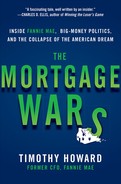Notes on Sources
The foundation of The Mortgage Wars is my knowledge and experience from 30 years in the financial services industry and 23 years as a senior executive at Fannie Mae. What made it possible for me to write it, however, was the fact that for eight years after I left Fannie Mae in 2004, I was enmeshed in litigation that caused me to delve deeply into many of the issues and areas that I focused on in this book. My review of hundreds if not thousands of documents during this process was of immeasurable value in refreshing my memory as I reconstructed the situations, circumstances, and events I relate in the book. In addition, in writing the narrative of the mortgage wars, I was fortunate to be able to draw on a wealth of publicly available information to give immediacy to the story and bring it to life.
A major theme of the book is the divergence between what was happening with Fannie Mae as a business and what was happening to it politically. Virtually all of the data cited in the book for the Fannie Mae business story come from information put out by the company in annual or monthly reports or from other public sources. The nuances on and insights into those data—including the discussions of Fannie Mae’s risk management practices—draw on my personal experience, in many cases confirmed by internal documents accumulated while at the company.
Fannie Mae was the subject of numerous studies by government agencies, going back to the early 1980s. The Congressional Budget Office did studies of Fannie Mae in 1983, 1991, 1996, and 2001; the General Accounting Office did Fannie Mae studies in 1985, 1990, 1991, and 1996; the Department of Housing and Urban Development’s Fannie Mae studies were in 1991 and 1996; and Treasury did studies of Fannie Mae in 1990 and 1996. Collectively, these studies are a treasure trove of historical facts about Fannie Mae and its business environment.
In telling the Fannie Mae political story, I benefited greatly from access to a large set of articles from major newspapers and magazines that I began clipping and retaining shortly after the formation of the lobbying group FM Watch in 1999. Material from those articles proved invaluable in recreating the political dynamic that played out during the years of Frank Raines’s chairmanship. Where there were gaps, contemporaneous articles from the Wall Street Journal, Washington Post, New York Times, American Banker, and other sources generally were available through my online research. A number of former Fannie Mae executives also shared their recollections and insights in interviews I conducted as I wrote the book.
The 2008 financial crisis and the events leading up to it have been covered extensively, and I tapped a number of sources to help tell that aspect of the story. Particularly valuable were the report of the Financial Crisis Inquiry Commission published in January 2011 and materials released by the House Oversight Committee in December 2008. Of the many books written on the financial crisis, I found All the Devils Are Here by Bethany McLean and Joe Nocera and On the Brink by former Treasury Secretary Hank Paulson to be especially useful.
At several points in the book, I relied on specific reference sources to refresh or supplement my knowledge of the topics I was writing about.
For information on the evolution of the mortgage finance industry following the Depression in Chapter 3 (“Birth, Trial, and Turnaround”) and for my brief discussion of the thrift crisis of the 1980s in Chapter 5 (“The Volcker Standard Gives Fannie Mae an Edge”), I drew on material from three books—The Fateful History of Fannie Mae by James Hagerty, From Buildings and Loans to Bailouts: A History of the American Savings and Loan Industry 1831–1995 by David L. Mason, and An Examination of the Banking Crises of the 1980s and Early 1990s from the Federal Deposit Insurance Corporation—along with a paper by Kenneth A. Snowden titled “Anatomy of a Mortgage Crisis: A Look Back to the 1930s,” prepared for The Panic of 2008 conference at George Washington University Law School in June 2009.
Chapters 7 and 8 (“Conflicts with Fast-Growing Lenders” and “A Surprise from the Treasury Department”) address the deregulation and consolidation of the financial services industry in the 1980s and 1990s. I found useful facts and information on these topics in three publications from different Federal Reserve district banks: “Investigating the Banking Consolidation Trend” in the spring 1991 Federal Reserve Bank of Minneapolis Quarterly Review; “Explaining the Rising Concentration of Banking Assets in the 1990s” in the August 2000 edition of Current Issues in Economics and Finance from the Federal Reserve Bank of New York; and “Changes in the Size Distribution of U.S. Banks: 1960 to 1995” from the fall 2006 Federal Reserve Bank of Richmond Economic Quarterly. Also helpful were a September 2011 article from the Journal of Business and Economics Research titled “Consolidation in the U.S. Banking Industry Since Riegle-Neal” and a July 2009 publication from the Center for Economic Policy Research called A Short History of Financial Deregulation in the United States.
Finally, I found good background material for my discussions of subprime mortgage lending in Chapter 9 (“Private-Label Mortgage-Backed Securities”) and Chapter 12 (“Private Label Takes Center Stage”) in the July 20, 2000, report of the joint HUD-Treasury Task Force on Predatory Lending and in “The Evolution of the Subprime Mortgage Market” from the January/February 2006 edition of the Federal Reserve Bank of St. Louis Quarterly Review.
While I have taken great care to verify and confirm all of the factual information contained in this book, it is possible that some errors may have gone undetected. For any such instances, I am solely responsible.
